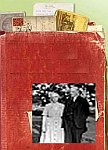 It is a truth universally acknowledged…that it is the habitual human tendency to tuck away nearby photographs, letters, and other articles into the pages of a beloved book. Whether these objects are placed among the pages for the sole purpose of marking one’s progress in the book, or to perhaps protect a valuable paper memorabilia from the elements, these materials now serve as far more than what they were originally intended for.
It is a truth universally acknowledged…that it is the habitual human tendency to tuck away nearby photographs, letters, and other articles into the pages of a beloved book. Whether these objects are placed among the pages for the sole purpose of marking one’s progress in the book, or to perhaps protect a valuable paper memorabilia from the elements, these materials now serve as far more than what they were originally intended for.
While these forgotten materials may have been placed within the book for a purpose of convenience, they now represent fragments of the person who had read the book and the life that they once lived. Faded photographs, yellowed letters from a dear acquaintance, blurred receipts, and handwritten phone numbers on wrinkled sticky notes all reveal some past activity to the current beholder of the book.
Just recently, I was leafing through a recent purchase, and was startled to find a loose note within the book from the author of the book to one of his colleagues. The book was Andrew Spielman’s Mosquito, and the note buried within his work of science was addressed to the Nobel Prize winner in Physiology or Medicine, Thomas Huckle Weller. Naturally, I was thrilled to come across this rare and unique letter from one renowned scientist to another, and my curiosity was instantly intrigued as to which of the two scientists had been the owner of the book prior to its sale. It truly gave a new significance to the book that I had just bought, as it encapsulated me into the middle of this unique interchange between the author and a Nobel Prize winner. Besides wondering as to how the note found its way into my book, however, I also wondered if its monetary value should be higher since its historic background was revealed. Does a note that is a separate entity apart from the book’s counterparts provide any appreciation to the book’s value, or does it instead perhaps constitute a separate collector’s item that will have its own following elsewhere?
While random objects from a person’s life are greatly of interest and all hold a place in history, sometimes particular documents that are found between the pages prove to be significantly rare and valuable. Such was the case with Ms. Malchodi, a book conservation technician at Brown University, who, according to The New York Times, one day opened an aged book on medicine and found to her complete surprise, an engraving of the baptism of Christ that was created by none other than Paul Revere! Besides the startling and arresting fact that Ms. Malcodi had found an original work by Revere, the work in itself has caused a great deal of excitement and extolment, as, unlike the great majority of Revere’s other works, this particular engraving had nothing whatever to do with patriotism or the Revolution. It instead offers evidence into Revere’s personal beliefs and spirituality which he considered as vital in his lifetime, just as today a proof of purchase or forgotten letter within a book offer hints as to the likes and interests of an individual. While the name Paul Revere instantly produces mental images of a brave and daring ride to warn of the approaching enemy on the brink of the American Revolution, Ms. Malchodi offered us a glimpse into a less popular window of Paul Revere’s life—his spirituality.
As long as the universal and age old habit of hiding away objects in the pages of a book persists, we will continuously be finding personal treasures and archives from a life once lived. While these discoveries may not always be as significant as Ms. Malchodi’s, they are still important in their own right, as they are the tracks left behind by an individual who has most likely since left life on earth. Of course, it is always wonderful when something valuable does present itself. As Ms. Malchodi could most certainly testify, one may never know what delightful and amazing discoveries may be found once a rare book is opened.
Hidden treasures between the pages
Previous post: Wollstonecraft – First Tsunami Wave of Feminism
Next post: The birth of the science of modern politics
{ 0 comments… add one now }
{ 1 trackback }